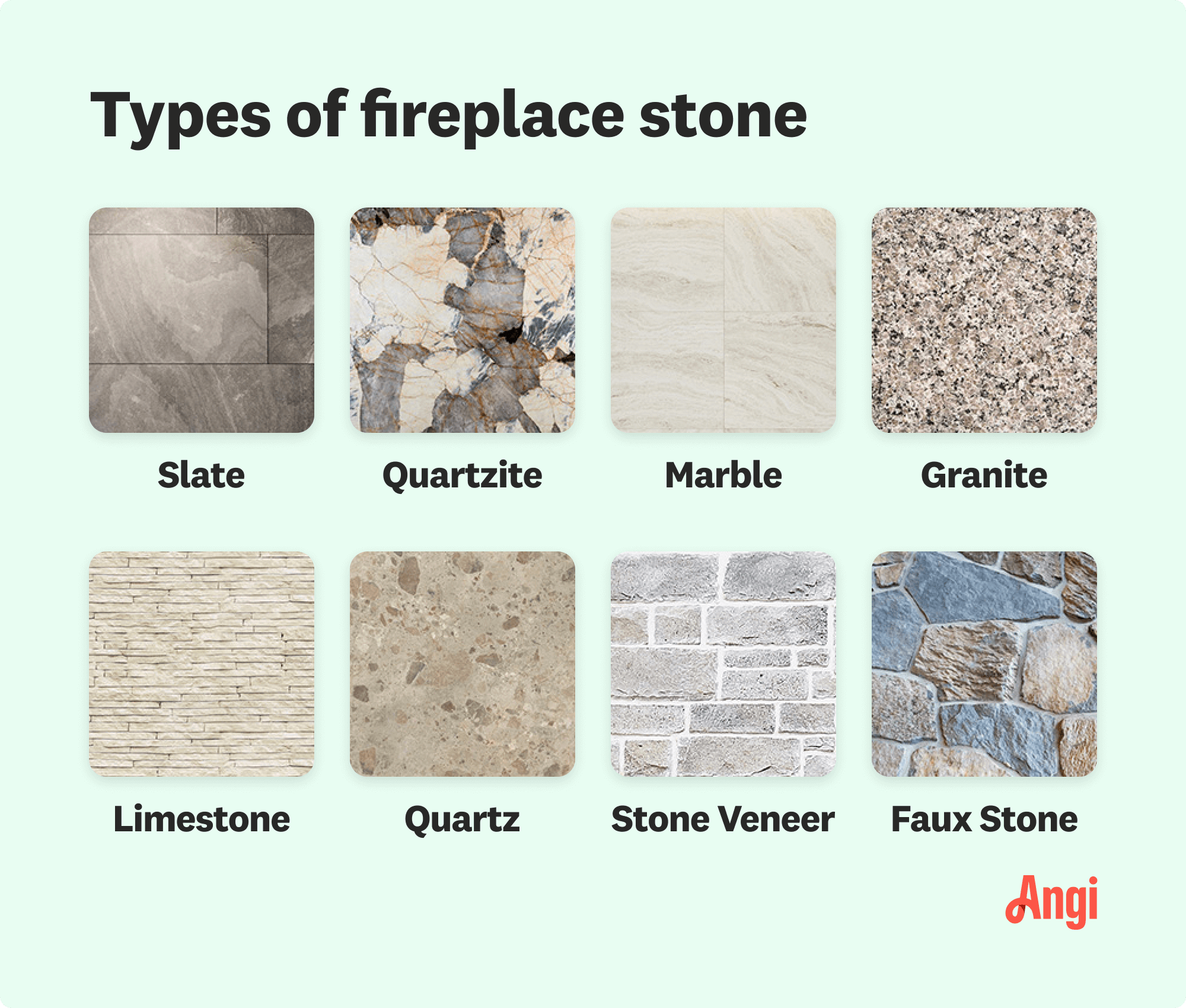8 Types of Stones for a Fireplace Surround
Learn your stacked limestone from your marble slabs


From a sleek, minimalist look to a rustic, cabin-in-the-woods vibe, stone is an extremely versatile material for your fireplace. There are several types of stone for a fireplace: slate, quartzite, marble, granite, limestone, quartz, stone veneer, and faux stone. With so many options, it’s easy to find one that fits both your home’s aesthetic and budget. Explore the different types of stone for fireplaces and find which one will work best for your fireplace.

1. Slate
Slate is a good option for fireplace surrounds, combining a modern look with a warm, cozy ambiance. This material is a metamorphic rock in thin but hefty sheets, often in black or gray tones, but you can also find slate in green, blue, or even red tones. No matter what color you choose, slate comes with natural variations that make every project unique.
Because slate is a high-end and heavy material, installation costs are higher compared to other types of fireplace stone, like limestone. Also, it easily scratches, so take extra care when cleaning around the fireplace to avoid leaving behind scuffs. Because it can be vulnerable to high heat, reserve slate for the surround of a gas fireplace or an electric unit rather than wood-burning fireplaces.
| Pros | Cons |
|---|---|
| Low-maintenance | Higher cost |
| Unique texture | Heavy |
| Hides dirt and stains | Prone to scratches |
Best for: Gas or electric fireplaces
2. Quartzite

Quartzite is a natural stone that offers a look similar to marble or granite. While quartzite isn’t entirely non-porous like quartz, veneer, or other human-made stones, it isn’t as porous as marble or limestone. This means you can skip sealing the stone, cutting back on some of the fireplace maintenance you need to handle.
Quartzite is durable against many common problems, including heat, scratches, and dents, but you’ll have to pay a higher cost, around $60 to $200 per square foot. You’ll also need to use gentle cleansers on quartzite because it’s vulnerable to etching.
| Pros | Cons |
|---|---|
| Low-maintenance | High cost |
| High durability | Prone to etching |
| Less porous | Difficult to install |
Best for: All fireplace types
3. Marble

If you’re dreaming of a glamorous living space where the fireplace is the focal point, you can’t go wrong with marble. This show-stopping stone features patterns of thick to thin veining and comes in a wide variety of colors. Because the material is vulnerable to moisture and acidity, sealing it will preserve the stone for longer. Marble is one of the most expensive types of stone for a fireplace, so be sure to budget accordingly if it’s the stone you want for your home.
Marble is heavy, so you’ll need to make sure your foundation is properly prepped to handle the larger load. You should also leave marble fireplace installation—and all fireplace installation, really— to a local fireplace installer.
| Pros | Cons |
|---|---|
| Luxury look | Higher cost |
| Highly durable | Porous |
| Many design choices | Difficult installation |
Best for: All fireplace types and those who want a high-end, luxury look
4. Granite
Granite is an igneous rock that comes in a wide range of colors and patterns, and you can even find granite options that mimic marble for a lower cost. While it may not cost quite as much as marble, granite is a high-end material that still costs more than other options on this list, like limestone and stone veneer. Like other natural stones, granite benefits from sealant to better protect it against moisture and discoloration, but otherwise, you can enjoy the scratch- and heat-resistant benefits of this extremely durable stone.
| Pros | Cons |
|---|---|
| Variety of designs | Porous |
| Extremely durable | Prone to discoloration |
| Stain-resistant | Higher cost |
Best for: Gas or wood-burning fireplaces
5. Limestone

Limestone is a sedimentary rock that comes in soft, neutral beige tones. This allows a stacked stone fireplace made of limestone to fit into many different decor styles, from traditional and rustic to minimalist and contemporary. This material is durable, so you don’t have to worry about accidentally scratching or denting the stone when maintaining your fireplace.
It’s also easy to clean, but limestone can be very absorbent. To better protect against erosion and stains, apply a sealant to your limestone fireplace.
| Pros | Cons |
|---|---|
| Lower cost | Absorbent |
| Low-maintenance | Limited color options |
| High durability | Needs sealant |
Best for: All fireplace types and those on a budget
6. Quartz
Not to be confused with quartzite (which is a natural stone), quartz fireplaces are made of crushed quartz rock, a type of igneous rock, and resins. Because it isn’t made entirely with natural stone, quartz is non-porous, so there’s no need to seal the fireplace. This material holds up well against moisture, acidity, and heat, although quartz isn’t as heat-resistant as other stones, like limestone and granite.
Because manufacturers can add pigment to quartz, it can be made into a wide range of colors to suit any style. However, if you want to add a more natural element to your space, quartz doesn’t offer quite the same look as 100% natural stone—although it may be a good compromise between natural and faux stone.
| Pros | Cons |
|---|---|
| Non-porous | Lower heat resistance |
| Low-maintenance | Prone to discoloration |
| Wide design variety | Less sustainable |
Best for: Gas and electric fireplaces
7. Stone Veneer

Stone veneer is made with thin pieces of natural stone or concrete. The veneer makes the material not only lightweight but also easier to install, especially because the pieces are manufactured in uniform sizes. Depending on the material, stone veneer can be durable against scratches, dents, stains, and other damage.
They aren’t invincible, though. Stone veneer needs to be sealed well or moisture can become trapped between and behind the panels.
| Pros | Cons |
|---|---|
| Lightweight | Vulnerable to moisture |
| Easy to install | Requires sealant |
| Uniform design | Less natural look |
Best for: All fireplace types
8. Faux Stones
If you want the look of natural stone for less, consider faux stones. These stones are made from materials like cement and plastic, so they cost less but offer plenty of durability for a fireplace surround. Compared to natural stone, these materials are easier to keep clean and maintain, and you can skip the sealant. Plus, they can be made to look like a wide range of different natural stones.
Keep in mind that the high heat from a fireplace can wear down faux stones over time, leading to discoloration or even cracking in plastic-based faux stones.
| Pros | Cons |
|---|---|
| Lower cost | Less natural look |
| Wide design variety | Prone to discoloration |
| Easy to clean | Prone to cracking |
Best for: Gas or electric fireplaces
